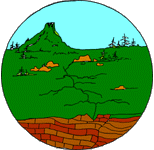|
|
||||||||||||||||||
1. The Earth was trembling under Giuseppe's feet. He
could not stand up as the dishes and books were being thrown around the
room. He could not understand what was going on, except that he had been
bad the day before. Could some unknown force be mad at him? Which of the
following could be actually happening?
2. Two volcanoes stand next to each other. These volcanoes however, produced different looking rocks. Which of the following factors does not influence the appearance of the rocks?
3. Earthquakes releases energy which travels by _________.
4. On October 17, 1989 an earthquake struck the San Francisco Bay area in California. The epicenter of this earthquake was at Loma Prieta. A seismograph located 50 miles away recorded the event. Which wave was recorded first on the seismogram?
5. A "P" wave travels in which motion?
6. Which of the following seismograms refer to a strong earthquake? Each was measured 50 miles from the epicenter of the earthquake.
7. Which state is more likely to have an earthquake?
8. The radius of the Earth is approximately _________.
9. The inner core of the Earth is solid and is probably composed of _________.
10. Which of the following combinations refers to the 3 types of plate boundaries?
11. The following pictures refers to the three types of plate boundaries, select the correct combination.
12. Maple syrup _____________________ than water.
13. Which of the following diagrams corresponds to a mild earthquake? Each of the seismograms were taken 50 miles from the epicenter.
ANSWERS: 1.(A); 2.(D); 3.(C); 4.(A); 5.(D); 6.(B); 7.(C); 8.(A); 9.(B); 10.(C); 11.(A); 12.(B); 13.(A) |

 Plate
Tectonic
Plate
Tectonic 





